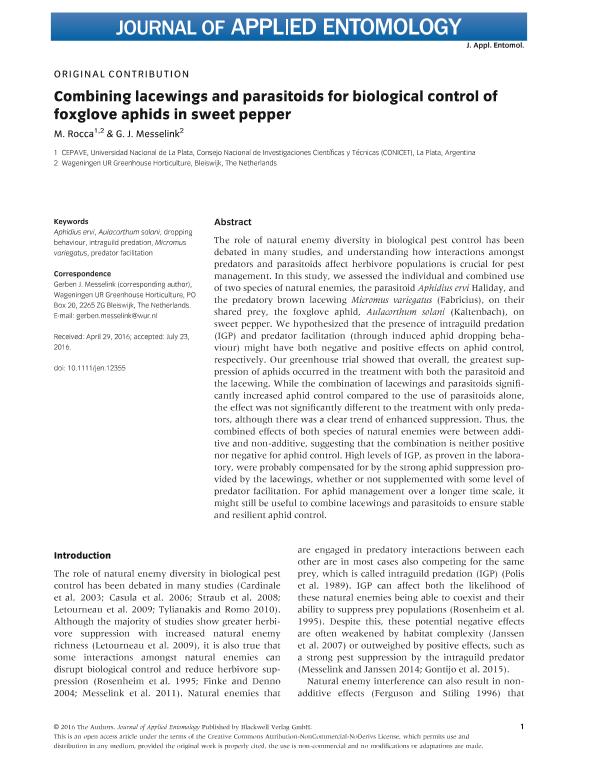Mostrar el registro sencillo del ítem
dc.contributor.author
Rocca, Margarita

dc.contributor.author
Messelink, Gerben J.
dc.date.available
2018-06-18T20:23:56Z
dc.date.issued
2017-06
dc.identifier.citation
Rocca, Margarita; Messelink, Gerben J.; Combining lacewings and parasitoids for biological control of foxglove aphids in sweet pepper; Wiley Blackwell Publishing, Inc; Journal of Applied Entomology; 141; 5; 6-2017; 402-410
dc.identifier.issn
0931-2048
dc.identifier.uri
http://hdl.handle.net/11336/49126
dc.description.abstract
The role of natural enemy diversity in biological pest control has been debated in many studies, and understanding how interactions amongst predators and parasitoids affect herbivore populations is crucial for pest management. In this study, we assessed the individual and combined use of two species of natural enemies, the parasitoid Aphidius ervi Haliday, and the predatory brown lacewing Micromus variegatus (Fabricius), on their shared prey, the foxglove aphid, Aulacorthum solani (Kaltenbach), on sweet pepper. We hypothesized that the presence of intraguild predation (IGP) and predator facilitation (through induced aphid dropping behaviour) might have both negative and positive effects on aphid control, respectively. Our greenhouse trial showed that overall, the greatest suppression of aphids occurred in the treatment with both the parasitoid and the lacewing. While the combination of lacewings and parasitoids significantly increased aphid control compared to the use of parasitoids alone, the effect was not significantly different to the treatment with only predators, although there was a clear trend of enhanced suppression. Thus, the combined effects of both species of natural enemies were between additive and non-additive, suggesting that the combination is neither positive nor negative for aphid control. High levels of IGP, as proven in the laboratory, were probably compensated for by the strong aphid suppression provided by the lacewings, whether or not supplemented with some level of predator facilitation. For aphid management over a longer time scale, it might still be useful to combine lacewings and parasitoids to ensure stable and resilient aphid control.
dc.format
application/pdf
dc.language.iso
eng
dc.publisher
Wiley Blackwell Publishing, Inc

dc.rights
info:eu-repo/semantics/openAccess
dc.rights.uri
https://creativecommons.org/licenses/by-nc-nd/2.5/ar/
dc.subject
Aphidius Ervi
dc.subject
Aulacorthum Solani
dc.subject
Dropping Behaviour
dc.subject
Intraguild Predation
dc.subject
Micromus Variegatus
dc.subject
Predator Facilitation
dc.subject.classification
Otras Ciencias Biológicas

dc.subject.classification
Ciencias Biológicas

dc.subject.classification
CIENCIAS NATURALES Y EXACTAS

dc.title
Combining lacewings and parasitoids for biological control of foxglove aphids in sweet pepper
dc.type
info:eu-repo/semantics/article
dc.type
info:ar-repo/semantics/artículo
dc.type
info:eu-repo/semantics/publishedVersion
dc.date.updated
2018-06-18T13:32:25Z
dc.journal.volume
141
dc.journal.number
5
dc.journal.pagination
402-410
dc.journal.pais
Reino Unido

dc.journal.ciudad
Londres
dc.description.fil
Fil: Rocca, Margarita. Consejo Nacional de Investigaciones Científicas y Técnicas. Centro Científico Tecnológico Conicet - La Plata. Centro de Estudios Parasitológicos y de Vectores. Universidad Nacional de La Plata. Facultad de Ciencias Naturales y Museo. Centro de Estudios Parasitológicos y de Vectores; Argentina
dc.description.fil
Fil: Messelink, Gerben J.. University of Agriculture Wageningen; Países Bajos
dc.journal.title
Journal of Applied Entomology

dc.relation.alternativeid
info:eu-repo/semantics/altIdentifier/doi/http://dx.doi.org/10.1111/jen.12355
dc.relation.alternativeid
info:eu-repo/semantics/altIdentifier/url/https://onlinelibrary.wiley.com/doi/abs/10.1111/jen.12355
Archivos asociados
